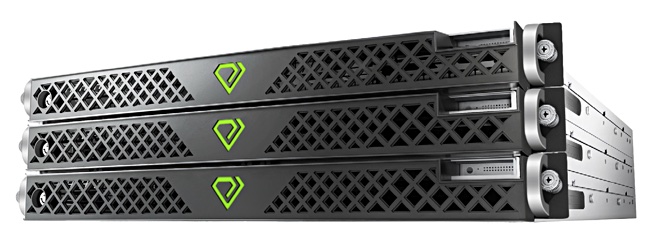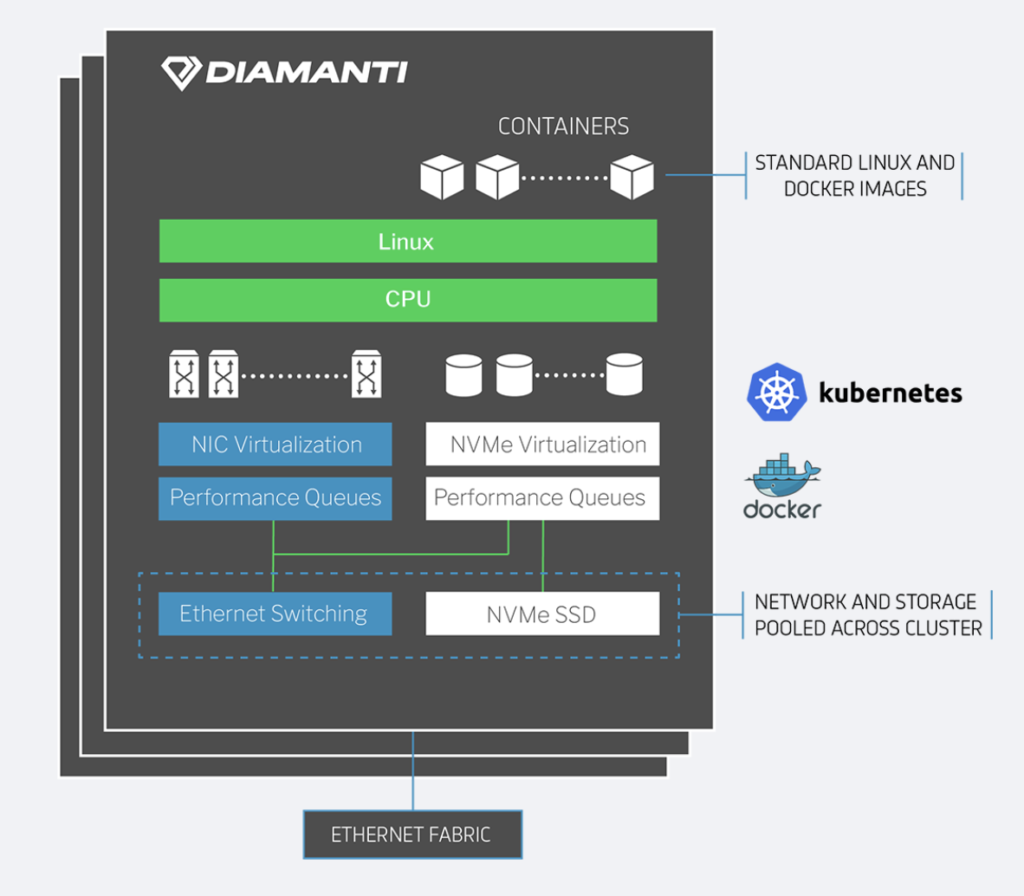Profile: Diamanti has built a bare metal Kubernetes container platform with persistent all-flash storage.
The California startup was founded in 2014 by three Cisco UCS server veterans and has taken $78m in four funding rounds.
It claims the Diamanti Enterprise Kubernetes Platform delivers the lowest total cost of ownership for cloud-native execution hardware and software. Diamanti’s roadmap includes a software-as-a-service, additional hardware products and extended software.
The company’s basic idea is to run containerised apps in a clustered bare metal hyperconverged system. Network and storage virtualization is offloaded from the main CPU complex to a subordinate smart PCIe card running CNI and CSI software.
It says the technology is more efficient than a server with a virtualization layer that runs applications in virtual machines, each with their own operating system and clogging up CPU cycles.
Hardware
According to Diamanti, its D20 hyperconverged system achieves sub-100 microseconds read and write latency and can performs up to 1 million IOPS. The firm claims the D20 is orders of magnitude more performant than running containers on virtual machines.
GPUs can be added to the D20 as a go faster option, to make a better fit for AI and machine learning-type workloads. These support Nvidia’s NVLink cross connect GPU cards.
Also, Diamanti offers the D20 RH system which is Red Hat certified for running Red Hat’s OpenShift Container Platform.
The D20 uses the same basic hardware design as its predecessor, the D10. The system is built with 1U dual Xeon CPU nodes.

A D20 node has 22, 32 or 44 cores and 192GB, 384GB or 768GB RAM. Direct-attached all-flash storage is 4 x 1TB, 2TB or 8TB Intel NVMe SSDs, providing 4TB, 8TB and 32TB configurations. There are 2 x 480 SATA SSDs for the host Linux OS and Docker image storage.

Nodes are clustered using 4 x 10 GbitE via a single 40 GbitE QSFP+ connection per node. Container orchestration is via Kubernetes v1.3 and the container runtime system is Docker v1.13.
Software matters
A Diamanti deep dive, written by Sambasiva Bandarupalli, states: “Designing a storage system for a bare metal container platform presented an immediate advantage: it was possible to use a log-structured file system, which is ultimately friendly to flash in terms of prolonging its endurance. The algorithms we’ve designed allow for us to perform nearly-sequential writes of data in 4K blocks.
“By contrast, a virtualized stack doesn’t employ a log-structured file system. The hypervisor has to field and translate IO requests to specific storage drives, which takes time. As a result, writes are scattered, essentially becoming random writes.
“Our approach ensures that every IO that comes in goes through a fixed path, which enables us to guarantee deterministic latency for all types of IO (reads, writes, random or sequential).”
D20 software provides per-container quality of service and includes mirroring between nodes, snapshots, backup and restore, and replication.

The company’s Diamanti Spektra software, currently in tech preview mode, provides hybrid cloud data management to integrate on-prem D20 clusters with the AWS, Azure and Google clouds. This raises the prospect of Diamanti D20 software running in those clouds and providing a single Kubernetes system across the on-premises and public cloud worlds.
Diamanti’s competition
To succeed against commodity hardware-based competitors, Diamanti needs to deliver significant speed and cost advantages with its hot box proprietary hardware.
451 Research, in a report published Feb 20 on Diamanti’s website, lists several established hyperconverged infrastructure players as competitors. They include VMware with vSphere 7, HPE’s Container Platform, NetApp’s NKS, Nutanix Karbon, and Cisco’s HyperFlex, with its Application Platform for Kubernetes.
In common with Diamanti, HPE Container Platform and Cisco HyperFlex support bare metal servers.
Smaller competitors include DataCore and LINBIT – which have their own hyperconverged systems – and MayaData, Portworx, Quobyte, StorageOS and Virtuozzo.








